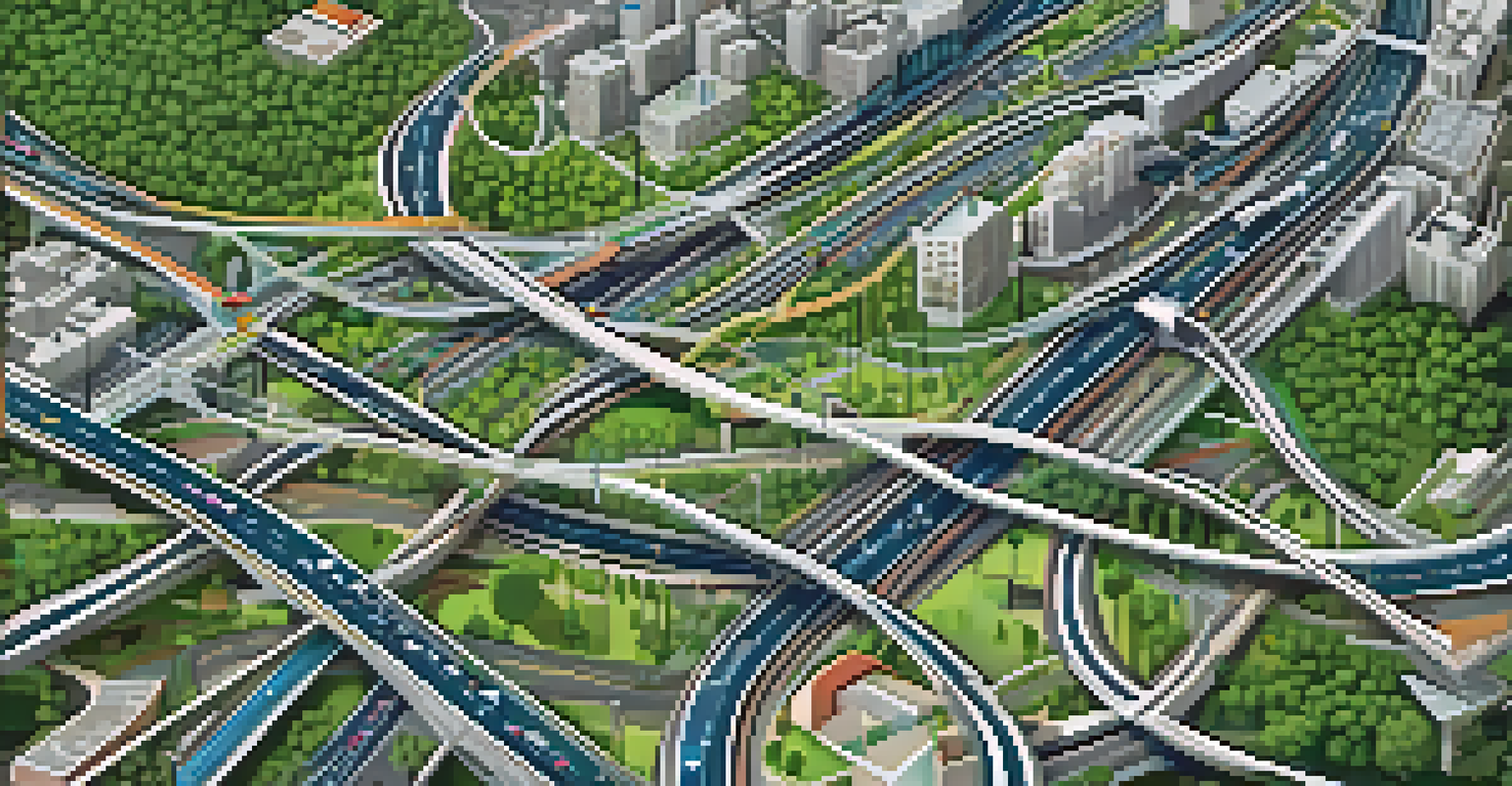The Role of Data Analytics in Urban Traffic Management

Understanding the Need for Traffic Management Solutions
Urban areas are bustling with activity, and with that comes congestion and delays. As populations grow, the demand for efficient transportation systems increases, making traffic management solutions essential. Without these systems, cities can become gridlocked, negatively impacting the economy and quality of life.
Data is the new oil, and analytics is the new combustion engine.
Traffic management isn't just about fixing problems; it's about proactively planning for future needs. This involves understanding patterns in traffic flow, identifying peak hours, and addressing areas prone to congestion. Effective management can lead to smoother commutes, reduced emissions, and a more enjoyable urban experience.
As cities evolve, so do their challenges. Data analytics plays a vital role in addressing these challenges by providing insights that inform better decision-making. By leveraging data, urban planners can create systems that adapt to changing conditions, ensuring traffic flows more freely.
The Role of Data Collection in Traffic Management
Data collection is the backbone of any effective traffic management strategy. Sensors, cameras, and GPS devices gather real-time information about vehicle speeds, traffic density, and even pedestrian movements. This wealth of data helps city officials understand how roads are used throughout the day.

By analyzing this data, cities can identify bottlenecks and determine where improvements are needed most. For example, if data shows that a particular intersection experiences frequent delays, planners can explore options like signal optimization or additional lanes. This targeted approach ensures that resources are allocated where they can make the most difference.
Data Drives Effective Traffic Solutions
Utilizing data collection and analysis is essential for cities to identify traffic patterns and make informed decisions to enhance urban mobility.
Moreover, the advent of smart cities has revolutionized data collection. As urban areas implement more connected devices, the depth and accuracy of data available for analysis improve significantly. This transition is essential for developing innovative solutions to urban traffic management challenges.
Analyzing Traffic Patterns for Better Insights
Once data is collected, it's time to analyze it to uncover traffic patterns. This involves using statistical methods and algorithms to interpret the data and extract meaningful insights. For instance, understanding peak travel times can help cities adjust signal timings to reduce wait times.
An ounce of prevention is worth a pound of cure.
Data analytics can also reveal long-term trends, such as how seasonal changes affect traffic flow. By recognizing these patterns, city planners can make informed decisions about infrastructure investments, such as expanding roads or adding public transit options. This proactive stance ultimately leads to more resilient traffic systems.
Additionally, traffic pattern analysis can help predict future conditions based on current trends. By using predictive analytics, cities can prepare for expected increases in traffic due to new developments or events, ensuring that they remain ahead of the curve.
Implementing Smart Traffic Signals and Systems
Smart traffic signals are a prime example of how data analytics can enhance urban traffic management. These systems use real-time data to adjust signal timings based on current traffic conditions, minimizing delays and improving flow. For example, during rush hour, signals can prioritize main routes to accommodate more vehicles efficiently.
Beyond just signals, smart traffic systems can integrate various forms of transportation, such as buses and bicycles. By analyzing data from different modes of transport, cities can create a more cohesive transit experience. This integration not only eases congestion but also encourages more sustainable travel options.
Smart Systems Improve Urban Flow
Implementing smart traffic signals and integrated systems allows cities to optimize traffic management and reduce congestion through real-time adjustments.
Moreover, these systems can communicate with drivers through apps or digital signage, providing real-time information about traffic conditions and alternative routes. This level of connectivity empowers travelers to make informed decisions, ultimately contributing to a smoother urban transport experience.
Enhancing Public Transportation with Data Analytics
Public transportation is a critical component of urban traffic management, and data analytics plays a significant role in its optimization. By analyzing ridership data, transit authorities can identify patterns and adjust schedules to better meet demand. This results in improved efficiency and a better experience for commuters.
For example, if data shows that certain bus routes are consistently overcrowded during peak hours, adjustments can be made to increase service frequency. This not only alleviates congestion on public transport but also encourages more people to opt for it over driving, reducing overall traffic.
Furthermore, data analytics can enhance route planning and transit accessibility. By understanding where people live and work, cities can design routes that serve the most users, making public transportation a more attractive option for everyone.
Using Data to Promote Sustainable Transportation
Sustainability is becoming increasingly important in urban planning, and data analytics can help promote greener transportation options. By analyzing traffic data, cities can identify areas that would benefit from bike lanes or pedestrian zones, encouraging more eco-friendly travel methods.
For instance, if data shows high foot traffic in an area, planners can consider expanding sidewalks or adding bike-sharing stations. This not only reduces the reliance on cars but also enhances the overall urban environment, making it more pedestrian-friendly and enjoyable.
Sustainability Through Analytics
Data analytics promotes sustainable transportation options by identifying areas for bike lanes and pedestrian zones, encouraging eco-friendly travel methods.
Additionally, data can help assess the impact of electric vehicles (EVs) and charging infrastructure. By understanding current usage patterns, cities can strategically place charging stations, making it easier for residents to switch to electric options and contributing to a reduction in greenhouse gas emissions.
The Future of Urban Traffic Management with Data Analytics
As technology continues to evolve, the future of urban traffic management looks promising, with data analytics at its core. Innovations like artificial intelligence and machine learning are set to enhance data processing capabilities, leading to smarter traffic systems. These advancements will allow for even more precise predictions and automated traffic management.
Moreover, the integration of autonomous vehicles will further transform the landscape of urban traffic. As these vehicles communicate with traffic systems and each other, data analytics will play a crucial role in ensuring safe and efficient interactions on the road. This synergy could lead to a significant reduction in traffic congestion and accidents.

Ultimately, the key to successful urban traffic management lies in embracing data analytics. By leveraging insights and technology, cities can create safer, more efficient, and sustainable transportation systems that enhance the quality of life for all residents.